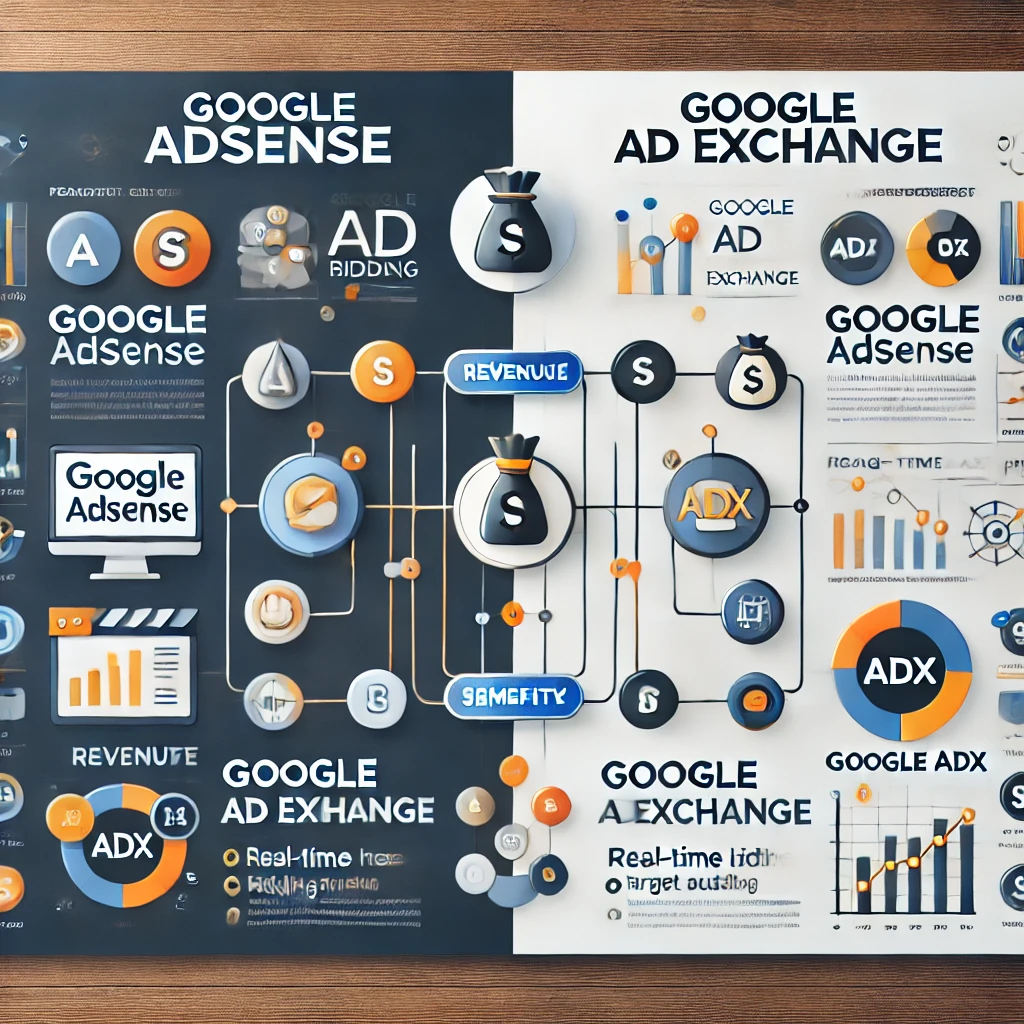Google offers several monetization tools for publishers to generate revenue from their websites or apps. Two of the most prominent platforms are Google AdSense and Google Ad Exchange (Google AdX). While both are designed to help publishers earn money from ads, they cater to different audiences and offer distinct features. In this detailed guide, we will compare Google AdX and AdSense to help you understand their differences and decide which platform suits your needs.

1. Overview of Google AdSense
Google AdSense is an easy-to-use platform designed for smaller publishers, individual website owners, or bloggers. It allows users to display ads on their websites and earn revenue based on user interactions such as clicks or impressions.
1.1. Key Features of Google AdSense
- Ease of Use: AdSense requires minimal technical knowledge and is beginner-friendly.
- Ad Formats: Supports various ad types, including text, display, video, and native ads.
- Revenue Model: Pay-per-click (PPC) and cost-per-thousand-impressions (CPM).
- Eligibility: Requires original content and adherence to Google’s content policies.
- Access: Available to individual publishers and small websites.
1.2. How Google AdSense Works
- Sign-Up: Publishers sign up for AdSense and integrate ad code into their website.
- Ad Placement: Google’s algorithm determines the best ads to display based on user interest and content relevance.
- Revenue: Publishers earn money from ad clicks and impressions.
2. Overview of Google Ad Exchange (Google AdX)
Google Ad Exchange, or AdX, is a more advanced platform tailored to premium publishers and large-scale websites. AdX operates as a real-time bidding (RTB) marketplace where multiple advertisers compete to place ads on a publisher’s site, maximizing revenue potential.
2.1. Key Features of Google AdX
- Real-Time Bidding: Advertisers bid for ad space in real time, driving up ad prices.
- Advanced Targeting: Offers more sophisticated audience segmentation and targeting options.
- Access to Premium Advertisers: Connects publishers with high-paying, premium ad networks.
- Revenue Model: Primarily CPM-based, with higher earning potential due to competition.
- Eligibility: Requires a significant traffic volume and is accessible through Google Certified Publishing Partners.
2.2. How Google AdX Works
- Partnership: Publishers must work with a Google Certified Publishing Partner to gain access to AdX.
- Auction: Advertisers bid for inventory, and the highest bidder wins the ad placement.
- Revenue: Publishers benefit from competitive pricing, resulting in higher earnings.
3. Key Differences Between Google AdSense and Google AdX
| Feature | Google AdSense | Google AdX |
|---|---|---|
| Audience | Individual publishers, small websites | Premium publishers, large-scale websites |
| Access | Open to all eligible publishers | Requires significant traffic and partnership with Certified Partners |
| Revenue Model | PPC and CPM | Primarily CPM with real-time bidding |
| Ad Control | Limited | Advanced control over inventory and pricing |
| Advertiser Network | Standard advertisers | Access to premium, high-paying advertisers |
| Technical Complexity | Beginner-friendly | Requires advanced knowledge or partnership |
| Earning Potential | Moderate | High due to RTB and premium advertisers |
4. When to Use Google AdSense
Google AdSense is the ideal choice for:
- Small Websites: Websites with limited traffic and resources.
- Beginners: Those new to ad monetization who want a simple setup process.
- Personal Blogs: Individuals looking to earn extra income from their content.
- Low Maintenance: Publishers who prefer minimal effort in managing ad inventory and placements.
Advantages of Google AdSense
- Easy to set up and use.
- Does not require a partnership with a third party.
- Provides basic reporting and analytics.
- No minimum traffic requirements (but approval is subject to Google’s policies).
Disadvantages of Google AdSense
- Limited control over ad inventory.
- Lower revenue potential compared to AdX.
- Advertisers are less competitive, leading to lower CPM rates.
5. When to Use Google AdX
Google AdX is best suited for:
- High-Traffic Websites: Publishers with significant monthly traffic who want to maximize revenue.
- Premium Publishers: Those seeking advanced control over ad placements and access to premium advertisers.
- Media Companies: Organizations that require tailored ad solutions and higher earning potential.
- Advanced Monetization Strategies: Publishers who want to use sophisticated tools like header bidding and programmatic ads.
Advantages of Google AdX
- Access to high-paying, premium advertisers.
- Real-time bidding maximizes revenue.
- Advanced inventory management tools.
- Greater control over ad placement and pricing.
Disadvantages of Google AdX
- Requires partnership with a Certified Publishing Partner.
- Higher technical complexity.
- Only available to publishers with high traffic and premium content.
6. How to Transition from AdSense to AdX
If your website has grown significantly and you want to switch from AdSense to AdX, follow these steps:
- Evaluate Eligibility: Ensure your website meets AdX requirements (high traffic, premium content).
- Partner with a Certified Publishing Partner: Contact a Google Certified Partner to gain access to AdX.
- Optimize Inventory: Work with your partner to set up AdX and configure advanced ad placements.
- Monitor Performance: Use AdX analytics to track revenue and make necessary adjustments.
7. Conclusion
Both Google AdSense and Google AdX are powerful tools for monetizing digital content, but they cater to different audiences and needs. AdSense is perfect for beginners and small publishers looking for an easy and low-maintenance solution. On the other hand, AdX is designed for high-traffic websites and premium publishers who want to maximize their revenue potential through advanced tools and access to premium advertisers.
Understanding the differences between these platforms will help you choose the one that aligns with your website’s goals, traffic levels, and monetization strategy.